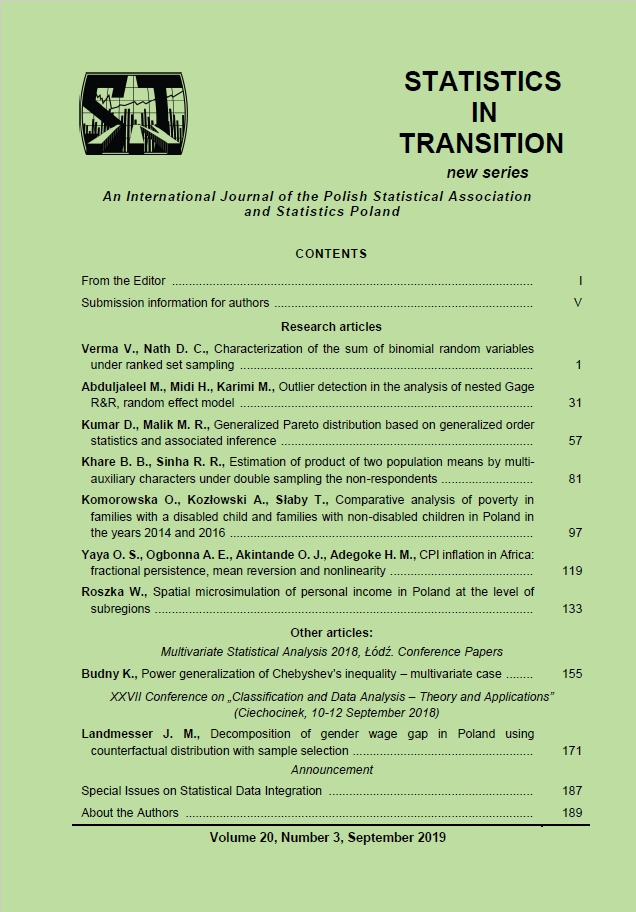ARTICLE
ABSTRACT
The paper presents an application of spatial microsimulation methods for generating a synthetic population to estimate personal income in Poland in 2011 using census tables and EU-SILC 2011 microdata set. The first section presents a research problem and a brief overview of modern estimation methods in application to small domains with particular emphasis on spatial microsimulation. The second section contains an overview of selected synthetic population generation methods. In the last section personal income estimation on NUTS 3 level is presented with special emphasis on the quality of estimates.
KEYWORDS
data integration, spatial microsimulation, small area estimation, synthetic data generation
REFERENCES
ALFONS A., KRAFT S., TEMPL M., FILZMOSER P., (2011). Simulation of close-to-reality population data for household surveys with application to EU-SILC. Statistical Methods and Applications, 20, pp. 383–407, Springer-Verlag.
BALLAS D., ROSSITER D., THOMAS B., CLARKE G.P., DORLING, D., (2005). Geography Matters: Simulating the Local Impacts of National Social Policies. York, Joseph Rowntree Foundation, UK.
D’ORAZIO M., DI ZIO M., SCANU M., (2006). Statistical Matching. Theory and Practice. John Wiley & Sons Ltd., England.
GOEDEMÉ T., (2013). Testing the Statistical Significance of Microsimulation Results: A Plea. International Journal Of Microsimulation, 6(3), pp. 50–77, International Microsimulation Association.
O’DONOGHUE C., (2014). Spatial Microsimulation Modeling: a Review of Applications and Methodological Choices. International Journal of Microsimulation, 7(1), pp. 26–75, International Microsimulation Association.
MUNOZ E., TANTON R., VIDYATTAMA Y., (2015). A comparison of the GREGWT and IPF methods for the re-weighting of surveys. 5th World Congress of the International Microsimulation Association (IMA).
MÜNNICH R., SCHÜRLE J., (2013). On the Simulation of Complex Universes in the Case of Applying the German Microcensus, DACSEIS research paper series no. 4.
NORMAN P., (1999). Putting Iterative Proportional Fitting on the Researcher’s Desk. School of Geography, University of Leeds, UK.
PENNECK S., (2007). Using administrative data for statistical purposes. Economic & Labour Market Review.
PHAM D.T., and KARABOGA D., (2000). Intelligent optimization techniques: genetic algorithms, taboo search, simulated annealing and neural networks. London, Springer.
RAHMAN A., (2008). A review of small area estimation problems and methodological developments. Online Discussion Paper - DP66, NATSEM, University of Canberra.
RAHMAN A., (2009). Small Area Estimation Through Spatial Microsimulation Models: Some Methodological Issues. Paper Presented at the 2nd International Microsimulation Association Conference, Ottawa, Canada, 8-10 June 2009, NATSEM, University of Canberra.
RAHMAN A., HARDING A., (2017). Small Area Estimation and Microsimulation Modeling. CRC Press, A Chapman & Hall Book, Boca Raton, Florida, USA.
RAHMAN A., HARDING A., TANTON R., LIU S., (2010). Methodological Issues in Spatial Microsimulation Modeling for Small Area Estimation. International Journal of Microsimulation, 3(2), pp. 3–22, International Microsimulation Association.
RAO J. N. K., (2003). Small Area Estimation. John Wiley & Sons.
RÄSSLER S., (2002). Statistical Matching. A Frequentist Theory, Practical Applications, and Alternative Bayesian Approaches. Springer, New York, USA.
STATISTICS NEW ZEALAND, (2006). Data Integration Manual.
SZYMKOWIAK M., BERE˛SEWICZ M., JÓZEFOWSKI T., KLIMANEK T., KOWALEWSKI J., MAŁASIEWICZ A., MŁODAK A., WAWROWSKI Ł., (2013). Mapy ubóstwa na poziomie podregionów w Polsce z wykorzystaniem estymacji pos´redniej. Urza˛d Statystyczny w Poznaniu, Os´rodek Statystyki Małych Obszarów.
SZYMKOWIAK M., MŁODAK A.,WAWROWSKI Ł., (2017). Mapping Poverty At The Level Of Subregions In Poland Using Indirect Estimation. STATISTICS IN TRANSITION new series, December 2017, Vol. 18, No. 4, pp. 609–635.
TANTON R., (2014). A Review of Spatial Microsimulation Methods. International Journal of Microsimulation, 7(1), pp. 4-25, International Microsimulation Association.
TANTON R., EDWARDS K. L. eds., (2013). Spatial Microsimulation: A Reference Guide for Users. Springer.
TANTON R., VIDYATTAMA Y., NEPAL B., MCNAMARA J., (2011). Small area estimation using a reweighing algorithm. Journal of the Royal Statistical Society, 174, Part 4, pp. 931–951.
TEMPL M., FILZMOSER P., (2014). Simulation and quality of a synthetic close-to-reality employer-employee population. Journal of Applied Statistics, Vol. 41, No. 5, pp. 1053–1072.
TEMPL M., MEINDL B., KOWARIK A., DUPRIEZ O., (2017). Simulation of Synthetic Complex Data: The R Package simPop. Journal of Statistical Software, August 2017, Vol. 79, Issue 10.
VOAS D., WILLIAMSON P., (2000). An evaluation of the combinatorial optimisation approach to the creation of synthetic microdata. International Journal of Population Geography, Vol. 6, pp. 349–366.
WALLGREN A., WALLGREN B., (2007). Register-based Statistics. Administrative Data for Statistical Purposes. John Wiley and Sons Ltd.
WAWROWSKI Ł., (2014). Wykorzystanie metod statystyki małych obszarów do tworzenia map ubóstwa w Polsce. Wiadomo´sci Statystyczne, Vol. 9, pp. 46–56.
WILLIAMSON P., (2013). An Evaluation of Two Synthetic Small-Area Microdata Simulation Methodologies: Synthetic Reconstruction and Combinatorial Optimization [in:] Spatial Microsimulation: A Reference Guide for Users. Springer.
WHITWORTH (edt), (2013). Evaluation and improvements in small area estimation methodologies. National Centre for Research Methods, Methodological Review paper, University of Sheffield.
WHITWORTH A., CARTER E., BALLAS D., MOON G., (2016). Estimating uncertainty in spatial microsimulation approaches to small area estimation: A new approach to solving an old problem. Computers, Environment and Urban Systems, http://dx.doi.org/10.1016/j.compenvurbsys.2016.06.004.
